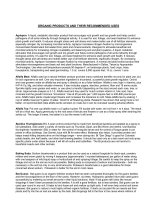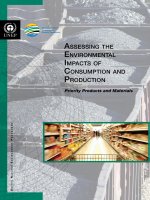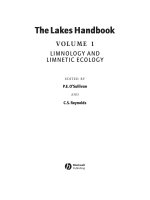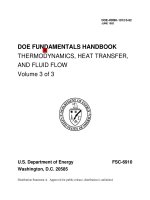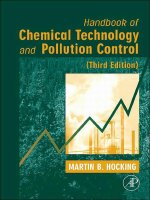petroleum fuels manufacturing handbook including specialty products and sustainable manufacturing techniques
Bạn đang xem bản rút gọn của tài liệu. Xem và tải ngay bản đầy đủ của tài liệu tại đây (2.23 MB, 463 trang )
PETROLEUM FUELS
MANUFACTURING
HANDBOOK
This page intentionally left blank
PETROLEUM FUELS
MANUFACTURING
HANDBOOK
Including Specialty Products and
Sustainable Manufacturing Techniques
Surinder Parkash, Ph.D.
New York Chicago San Francisco Lisbon London Madrid
Mexico City Milan New Delhi San Juan Seoul
Singapore Sydney Toronto
Copyright © 2010 by The McGraw-Hill Companies, Inc. All rights reserved. Except as permitted under the United States Copyright
Act of 1976, no part of this publication may be reproduced or distributed in any form or by any means, or stored in a database or
retrieval system, without the prior written permission of the publisher.
ISBN: 978-0-07-163241-6
MHID: 0-07-163241-7
The material in this eBook also appears in the print version of this title: ISBN: 978-0-07-163240-9, MHID: 0-07-163240-9.
All trademarks are trademarks of their respective owners. Rather than put a trademark symbol after every occurrence of a trademarked
name, we use names in an editorial fashion only, and to the benefit of the trademark owner, with no intention of infringement of the
trademark. Where such designations appear in this book, they have been printed with initial caps.
McGraw-Hill eBooks are available at special quantity discounts to use as premiums and sales promotions, or for use in corporate
training programs. To contact a representative please e-mail us at
Information contained in this work has been obtained by The McGraw-Hill Companies, Inc. (“McGraw-Hill”) from sources believed
to be reliable. However, neither McGraw-Hill nor its authors guarantee the accuracy or completeness of any information published
herein, and neither McGraw-Hill nor its authors shall be responsible for any errors, omissions, or damages arising out of use of this
information. This work is published with the understanding that McGraw-Hill and its authors are supplying information but are not
attempting to render engineering or other professional services. If such services are required, the assistance of an appropriate
professional should be sought.
TERMS OF USE
This is a copyrighted work and The McGraw-Hill Companies, Inc. (“McGraw-Hill”) and its licensors reserve all rights in and to the
work. Use of this work is subject to these terms. Except as permitted under the Copyright Act of 1976 and the right to store and retrieve
one copy of the work, you may not decompile, disassemble, reverse engineer, reproduce, modify, create derivative works based upon,
transmit, distribute, disseminate, sell, publish or sublicense the work or any part of it without McGraw-Hill’s prior consent. You may
use the work for your own noncommercial and personal use; any other use of the work is strictly prohibited. Your right to use the work
may be terminated if you fail to comply with these terms.
THE WORK IS PROVIDED “AS IS.” McGRAW-HILL AND ITS LICENSORS MAKE NO GUARANTEES OR WARRANTIES AS
TO THE ACCURACY, ADEQUACY OR COMPLETENESS OF OR RESULTS TO BE OBTAINED FROM USING THE WORK,
INCLUDING ANY INFORMATION THAT CAN BE ACCESSED THROUGH THE WORK VIA HYPERLINK OR OTHERWISE,
AND EXPRESSLY DISCLAIM ANY WARRANTY, EXPRESS OR IMPLIED, INCLUDING BUT NOT LIMITED TO IMPLIED
WARRANTIES OF MERCHANTABILITY OR FITNESS FOR A PARTICULAR PURPOSE. McGraw-Hill and its licensors do not
warrant or guarantee that the functions contained in the work will meet your requirements or that its operation will be uninterrupted
or error free. Neither McGraw-Hill nor its licensors shall be liable to you or anyone else for any inaccuracy, error or omission,
regardless of cause, in the work or for any damages resulting therefrom. McGraw-Hill has no responsibility for the content of any
information accessed through the work. Under no circumstances shall McGraw-Hill and/or its licensors be liable for any indirect,
incidental, special, punitive, consequential or similar damages that result from the use of or inability to use the work, even if any of
them has been advised of the possibility of such damages. This limitation of liability shall apply to any claim or cause whatsoever
whether such claim or cause arises in contract, tort or otherwise.
To my wife, Rita
This page intentionally left blank
ABOUT THE AUTHOR
SURINDER PARKASH,PH.D., has over three decades of experience in petroleum refining and
the related fields of process design, refinery operational planning, international marketing,
and project planning. He has worked with many well-known companies and organizations
such as Indian Institute of Petroleum, Iraq National Oil Company, Bahrain National Oil
Company, and Kuwait National Petroleum Company. He is the author of Petroleum
Refining Handbook, published by Gulf Professional Publishing. At present, Dr. Parkash is
president of NAFT-ASIA (www.naft-asia.com), an independent consulting firm.
This page intentionally left blank
ix
CONTENTS
Preface xv
Part 1 Petroleum Fuels
Chapter 1. Liquefied Petroleum Gas 3
Automotive LPG / 4
LPG Storage / 4
LPG Manufacture / 4
LPG Specifications / 10
Chapter 2. Naphtha 13
Naphtha Production / 13
Secondary Processing Units / 17
Naphtha Desulfurization / 18
Naphtha HDS Unit / 19
Naphtha Specifications / 21
LSR Naphtha / 21
Naphtha Uses / 23
Chapter 3. Gasoline 29
Gasoline Engine / 29
Gasoline Properties / 29
Gasoline Blend Components / 32
Pollution from Gasoline Combustion / 37
Catalytic Converter / 38
Gasoline Specifications / 39
Aviation Gasoline / 41
Racing Fuels / 46
References / 47
Chapter 4. Kerosene 49
Jet Engine / 49
Grades and Specifications / 50
Military Jet Fuel Specifications / 50
Jet Fuel Quality Characteristics / 57
Aviation Fuel Additives / 59
Miscellaneous Uses / 63
References / 64
Chapter 5. Diesel Fuels 65
Diesel Engines / 65
Specifications / 65
Diesel Fuel Emissions / 71
Diesel Fuel Additives / 74
Diesel Blending / 75
Distillate Heating Oils / 76
Biodiesels / 77
References / 80
Chapter 6. Residual Fuel Oils 81
Uses of Residual Fuels / 81
Diesel Engines / 82
Steam Boilers / 82
Gas Turbines / 82
Residual Fuel Oil Specifications / 82
Properties of Residual Fuel Oils / 85
Residual Fuel Oil Burning / 92
Residual Fuel Oil Blending / 94
Compatibility of Residual Fuel Oils / 96
References / 98
Part 2 Petroleum Specialty Products
Chapter 7. Bitumen 101
Bitumen Composition / 102
Bitumen for Pavement / 103
Bitumen Evaluation for Paving / 105
Bitumen Grading Systems / 113
Hot-Mix Asphalt / 117
Bitumen Test Methods / 118
Types of Bitumen / 122
Air Blowing Process / 131
Industrial Uses of Bitumen / 134
Storage and Handling of Bitumen / 137
References / 139
Chapter 8. Petroleum Coke 141
Manufacturing Processes / 141
Delayed Coking Process / 141
Operating Conditions / 145
Fluid Coking Process / 150
Petroleum Coke Types / 154
Properties of Calcined Coke / 156
Uses of Petroleum Coke / 158
Aluminum Smelting / 160
Titanium Dioxide Production / 161
Steel Production / 162
Graphite Electrodes / 162
References / 163
x
CONTENTS
Chapter 9. Carbon Black 165
Manufacturing Processes / 166
Channel Black Process / 166
Gas Black Process / 167
Thermal Black Process / 167
Acetylene Black Process / 167
Lamp Black Process / 168
Furnace Black Process / 168
Reactor / 169
Oxidized Carbon Blacks / 173
Carbon Black Properties / 174
Secondary Properties / 176
Carbon Black Test Methods / 177
Application and Uses / 179
Printing Inks / 185
Cosmetics Usage / 187
References / 188
Chapter 10. Lube Base Stocks 189
Conventional Process / 189
Catalytic Dewaxing / 206
American Petroleum Institute Classification of Base Oils / 209
References / 210
Chapter 11. Lubricating Oil Blending 211
Classification of Lubricating Oils / 211
Classification by Viscosity / 212
International Standards / 212
Classification by Additive Types / 212
Automotive Engine Oils / 212
Effect of Viscosity on Fuel Economy / 216
Automotive Oil Additives / 216
Viscosity Index Improvers / 217
Detergent Inhibitors / 219
Dispersants / 220
Anti-Wear/Extreme Pressure Additives / 221
Friction Modifiers / 222
Oxidation Inhibitors / 222
Rust and Corrosion Inhibitors / 223
Pour Point Depressants / 223
Antifoamant Additives / 223
Other Additives / 223
Additive Depletion / 224
Engine Oil Formulation / 225
Effect of Base Stock Quality / 228
American Petroleum Institute Service Classification / 229
Gear Oils / 229
SAE Gear Oil Classification / 230
Automotive Lubricants Test Methods / 231
Cold Crank Simulator (ASTM D 5293) / 233
Four-Ball Wear Test (ASTM D 4172) / 234
References / 234
CONTENTS xi
Chapter 12. Synthetic Lubricants 235
Polyalphaolefins / 236
Diesters / 236
Polyol Esters / 237
Polyalkylene Glycols / 238
Phosphate Esters / 239
Natural Esters / 240
Polyphenyl Ethers / 240
Fluorinated Lubricants / 241
Silicate Esters / 241
References / 242
Chapter 13. Turbine Oils 243
Base Oils / 243
Formulation / 244
Life of Turbine Oil / 245
Test Methods / 245
References / 247
Chapter 14. Used Oil Re-Refining 249
Burning as Fuel / 249
Re-Refining / 251
Re-Refining Processes / 251
Batch Acid-Clay Process / 251
Pretreatment / 255
Hydrofinishing Process / 255
References / 256
Chapter 15. Lubricating Greases 257
Grease Composition / 257
Base Oil / 258
Grease Thickeners / 258
Additives / 260
Grease Manufacture / 261
Lubricating Grease Quality / 263
Automotive Greases / 268
Aircraft Greases / 269
Heavy Machinery Greases / 269
Marine Greases / 272
High-Temperature Greases / 273
References / 275
Chapter 16. Waxes 277
Nonpetroleum Waxes / 277
Paraffin Waxes / 280
Properties / 281
Test Methods / 283
Petroleum Wax Manufacture / 285
References / 294
xii
CONTENTS
CONTENTS xiii
Chapter 17. Metalworking Fluids 295
Types of MWFs / 295
Functions of MWFs / 298
Blend Components of Cutting Oils / 299
Cutting Fluid Formulation / 301
Cutting Fluid Maintenance and Disposal / 301
References / 303
Chapter 18. Metal Finishing Quenchants 305
Heat Treating Processes / 305
Quenching/Hardening / 305
Types of Quenchants / 306
Three Stages of Heat Removal / 307
Accelerated Quenching / 308
Marquenching / 308
Mineral Quenching Oils / 308
Polymer Solutions / 310
Quench System Design / 310
Other Heat Treating Processes / 312
References / 312
Chapter 19. Hydraulic Fluids 313
Physical Properties / 314
Biodegradability / 316
Base Oils for Hydraulic Fluids / 316
Brake Fluids / 319
References / 320
Chapter 20. Petroleum Products as Pesticides 321
Spray Oils / 321
Chemical Insecticides / 325
References / 340
Chapter 21. Hydrocarbon Solvents 341
Nonpetroleum Solvents / 341
Petroleum-Based Solvents / 341
Major Applications of Petroleum Solvents / 344
References / 355
Chapter 22. Refrigeration Gases 357
Freons / 357
Refrigerants’ Name and Numbering Convention / 357
Aerosols / 361
Product / 361
Propellant / 362
Container / 364
xiv CONTENTS
Chapter 23. Transformer/Electrical Insulating Oils 365
Properties/Specifications / 365
Transformer Oils Manufacture / 370
References / 375
Chapter 24. White Mineral Oils 377
Properties of White Oils / 377
Uses of White Mineral Oils / 380
White Oil Manufacture / 381
Process Description / 382
Intermediate Product Storage / 382
Intermediate Product Nomenclature / 382
Sulfonate Blending / 385
Percolation / 387
Bauxite Processing / 388
New Bauxite Reactivation / 388
Naphtha Recovery / 389
Hydrotreating Process / 390
Hydroprocessed Base Stocks / 391
Petroleum Sulfonates / 391
Petrolatums / 392
References / 428
Appendix
429
Index 441
xv
PREFACE
Petroleum products are everywhere around us. They appear in visible forms, such as gasoline, diesel,
kerosene, and aircraft fuels, and in less visible forms over the entire spectrum of industry, such as
automobile lubricants, greases, carbon black for truck tires, bitumen for road building, the water-
proofing in house roofs, feedstock for petrochemicals, synthetic fibers, and plastics. Petroleum feed-
stock is used in the manufacture of white mineral oils in eye ointment, hair oils, cosmetics,
petroleum solvents, and pest control sprays. Transportation fuels, however, remain the most impor-
tant use of petroleum.
The consumption of petroleum products throughout the world is ever-increasing to meet the
rising energy needs of countries. But this rapid rise has led to undesirable air and water pollution
levels. Environmental pollution affects everyone on the planet. During the last two decades, the
manufacture and blending of petroleum products has changed rapidly, with a view to reduce atmos-
pheric pollution and conserve petroleum feedstock. The lead phaseout from gasoline, sulfur reduction
in all transportation fuels, and new lube-making technologies that produce longer-lasting engine oils
or lower fuel consumption are a few illustrations of these changes.
This book surveys the manufacture, blending, properties, specifications, and uses of petroleum
fuels and specialty products (products made out of petroleum feedstock for nonfuel use except petro-
chemicals). There are a very large number of specialty products—petroleum solvents, bitumen for
paving and industrial uses, lubricating oils, greases, white mineral oils, carbon black, petroleum
coke, spray oils, and so on—to meet the requirements of industry. Possibly far more technical per-
sonnel are engaged in petroleum specialty manufacture and the handling of petroleum products than
are found in refineries. Although petroleum fuels are generally made in refineries out of crude oil
distillation, petroleum specialty products are made in relatively smaller downstream units starting
with refinery streams as feedstock. A refinery may produce five or six basic products, such as liqui-
fied petroleum gas (LPG), naphtha, kerosene, diesel, and fuel oils, but specialty manufacturers may
produce a large number of their products from these basic refinery products. There is very little pub-
lished information on specialty manufacturing processes. The selection of a petroleum product for a
specific job has become more challenging. Specifications and the test methods used on petroleum
products are important for the proper selection of a petroleum product for a given end use.
Part 1, the first six chapters, is devoted to petroleum fuels. Part 2, the remaining chapters, deals
with petroleum specialty products. The book presents manufacturing processes, product blending,
and specifications of various petroleum products. To make the book useful to the professional in the
petroleum industry, an in-depth treatment of each subject not normally found in textbooks is pro-
vided. It is hoped that this book will be of direct interest to students and all those engaged in the man-
ufacture, blending, storage, and trading of petroleum products.
Surinder Parkash, Ph.D.
This page intentionally left blank
PETROLEUM FUELS
MANUFACTURING
HANDBOOK
This page intentionally left blank
PETROLEUM FUELS
P
●
A
●
R
●
T
●
1
This page intentionally left blank
CHAPTER 1
LIQUEFIED PETROLEUM GAS
3
Liquefied petroleum gas, commonly called LPG, is also known by the names of its principal generic
components, propane and butane. The normal constituents of LPG are propane (C
3
H
8
), propylene
(C
3
H
6
), butane (C
4
H
10
), and butylenes (C
4
H
8
). These are commercial products and may contain other
impurities such as smaller quantities of C
5
+ hydrocarbons. LPG as a liquid is colorless, and in vapor
form it cannot be seen. Pure LPG has no smell, but for safety reasons an odoring agent, usually a
mercaptan, is added during manufacture to aid detection at very low concentrations. LPG exists in a
gaseous form under normal atmospheric pressure and temperature. It is easily liquefied by moderate
pressure at ambient temperatures, which means it can be easily and conveniently stored as a liquid,
a big advantage over natural gas, which can be liquefied only at a very low temperature and high
pressure. LPG as a liquid is 250 times denser than LPG as vapor, so a large quantity can be stored
in a relatively small volume.
Table 1-1 shows the physical properties of LPG constituents. The boiling point at atmospheric
pressure of n-butane is 31.08°F and for propane is –43.7°F. Thus propane can be stored in liquid form
in tanks exposed to the atmosphere without the danger of freezing in cold winter ambient tempera-
tures. The calorific value of LPG on a volume basis is significantly higher (propane, 95 MJ/m
3
;
butane, 121 MJ/m
3
) compared with that of natural gas (38 MJ/m
3
). For this reason, natural gas appli-
ances and LPG appliances cannot be interchanged.
LPG has the following main uses:
1. LPG is the most versatile fuel used in domestic applications. It is used like natural gas and can
do everything that natural gas can do. LPG is used for cooking, central heating, space heating,
and hot water supply, as well as in a large number of appliances, such as ovens, stovetops, and
refrigerators in homes, hotels, and restaurants.
2. LPG is increasingly being used as automobile fuel because of its cost advantage over gasoline and
diesel. LPG is a clean-burning fuel. The absence of sulfur and very low levels of nitrogen oxides
(NOx) and particulate emissions during its combustion make LPG a most environmentally friend-
ly source of energy. The disadvantage is that LPG has a lower calorific value per unit volume, and
thus the vehicle has to refuel more frequently. In industry, LPG is used to power industrial ovens,
kilns, furnaces, and for various process heating applications. LPG is used in brick kilns and
aluminum die casting, in ceramics, and in glass manufacture. LPG is used to heat bitumen for road
building. It has other diverse uses, such as the following:
• In agriculture, for crop drying, waste incarnation, greenhouse heating, and running power
equipment.
• As a feedstock for chemical manufacture, in water desalination plants, and in aerosol manufac-
ture as a propellant.
• As a standby fuel for natural gas. LPG is used as automobile fuel in forklift trucks.
In developed countries, most of the LPG demand (more than 80 percent) is for the industrial sector;
less than 20 percent of the demand is for the domestic market. In the developing countries of Asia,
Africa, and South and Central America, the largest demand for LPG is in the domestic sector. The
rural communities that earlier were using biomass (e.g., wood and charcoal) as domestic fuel are now
switching over to LPG as the supply available is more.
AUTOMOTIVE LPG
Automotive LPG, or autogas, refers to the LPG used in automotive applications. LPG consists mainly
of propane, propylene, butane, and butylenes in various proportions. The composition of autogas
varies from country to country depending on the prevailing ambient temperatures. In moderate ambient
temperatures, autogas typically consists of 60 to 70 percent propane and 30 to 40 percent butane. The
addition of butane slows down combustion speed in an engine and reduces NOx emissions.
Components of LPG are gases at normal ambient temperature and pressure but can be easily lique-
fied for storage by an increase in pressure from 8 to 10 bar or a reduction in temperature. LPG used
in automobiles is stored in liquid form in an onboard steel cylinder. LPG has a long and varied history
in transportation applications. It is estimated that more than 4 million automobiles use LPG world-
wide at present. It has been used in rural farming areas as fuel for farm machinery. LPG is used for
some special applications such as forklifts in warehouses. The use of LPG can result in lower vehicle
maintenance costs, lower emissions, and fuel cost savings compared with conventional gasoline or
diesel fuels. LPG is considered a particularly suitable fuel for heavy vehicles, buses, and delivery
vehicles because of its significantly lower particulate emissions compared with diesel-powered
buses. The use of LPG as automotive fuel varies from country to country depending on the relative
cost of alternative fuels such as gasoline and diesel.
LPG STORAGE
For domestic applications, LPG is stored in 15-kg cylinders. Domestic bulk LPG tanks vary in size
from 200 to 2000 kg. They are installed outdoors on customer premises and LPG is delivered from road
tankers. The amount of gas delivered is recorded via an onboard meter and charged to the customer.
Storage tanks are usually installed aboveground. Propane is stored in a tank as a liquid under a pressure
of 7 to 10 bars (100 to 150 PSIA). The gas pressure is reduced in two stages to bring it to a safe working
pressure of 37 millibar (0.53 lb/in
2
), for which the gas appliances are usually designed to operate.
LPG MANUFACTURE
LPG from Field Gases
About 60 percent of the world supply of LPG comes from associated gas processing, and 40 percent
of the LPG is produced in oil refineries from crude distillation, fluid catalytic cracking units
(FCCUs), delayed cokers, hydrocrackers, and other conversion processes. The worldwide estimated
production of LPG in 2005 was estimated at 250 million tons per year.
4 PETROLEUM FUELS
TABLE 1-1 Properties of LPG Gases
Boiling point Critical Critical Specific Vapor pressure
1 ATM temperature pressure gravity at 100°F
Constituent Formula °F °F lb/in
2
60/60°F lb/in
2
Propane C
3
H
8
–43.75 206.06 616.00 0.5070 188.64
Propylene C
3
H
6
–53.86 196.90 669.00 0.5210 227.607
n-Butane C
4
H
10
31.08 305.62 550.60 0.5840 51.706
Isobutane C
4
H
10
10.78 274.46 527.90 0.5629 72.581
1-Butene C
4
H
8
20.73 295.59 583.00 0.6005 63.2775
Cis-2-Butene C
4
H
8
38.70 324.37 610.00 0.6286 45.7467
Trans-2-Butene C
4
H
8
33.58 311.86 595.00 0.6112 49.8821
Isobutene C
4
H
8
19.58 292.55 580 0.6013 64.583
Acid Gas Removal
The raw natural or associated gases from a group of wells are received in a knockout drum where
gas and liquid phases are separated. The gas is disentrained with the aid of a mist eliminator pad
incorporated in the knockout drum and then compressed by a gas compressor for pipeline trans-
port to an acid gas removal plant. Condensate separated in a knockout drum is injected back into
the gas stream after water separation. Water separated in the knockout drum is disposed of as
wastewater.
The oil field gases contain carbon dioxide and hydrogen sulfide, together known as acid gases.
Because these gases are corrosive, poisonous, or both, they are removed first before further process-
ing or LPG separation. Acid gases are separated from the gas stream by amine treating or by the
Benfield process in which gases are treated with a solution of potassium carbonate containing some
additives. The Benfield process uses an inorganic solution containing 25 to 35 wt % (percentage of
weight) K
2
CO
3
. The absorption is chemical not physical. Figure 1-1 shows the reactions.
The Benfield solution has vanadium pentoxide (V
2
O
5
), which results in higher gas loading, lower
circulation rate, and less corrosion. The absorber operates at 200 to 400°F.
Figure 1-2 shows a process flow diagram of acid gas (CO
2
and H
2
S) removal based on the Benfield
process. The gases and liquid coming from the field enter feed surge drum V-101, which removes any
entrained water. The gas and liquid feed are recombined, and the two-phase mixture is heated in E-101
by heat exchange with sweet gas coming from the top of acid gas absorber V-103. It is further heated
with 50 lb/in
2
steam in E-103. It is next fed to absorber V-103 near the bottom. A lean potassium car-
bonate solution is fed to the absorber at its top and middle sections. The rich solution reaching the bot-
tom of absorber is pumped to regenerator column V-104 via flash drum V-107. The sweet gas from
absorber V-103 overhead is cooled in heat exchanger E-101 and next by cooling water in E-102 on its
way to separator drum V-102 where the condensate is separated. Sweet gas exits the separator drum
V-102 for further processing in an LPG extraction unit. Water separated in the drum is returned to
flash drum V-107. Sweet hydrocarbon product is pumped out to mix with sweet gas from drum V-102.
Potassium carbonate solution rich in acid gas is regenerated in V-104. The solution is fed to the top of
a packed column. The rich solution is regenerated by reboiling with steam in reboiler E-106. The
lean solution is collected at the bottom of the column and returned to the absorber. Any makeup potas-
sium carbonate solution required by the absorber is drawn from carbonate storage drum V-106. The
regenerator overheads are condensed by air cooler E-105 and collected in regenerator accumulator
V-105. Acid gases remain uncondensed and exit V-105 to the sulfur plant.
Extraction Plant
The combined feed to extraction plant typically comprises associated gases and condensate from oil-
producing areas plus refinery gases after treating for acid gas removal. The extraction process
involves feed compression, feed/effluent heat exchange, dehydration, absorption, and stripping.
Three product streams are produced; a liquid stream rich in propane, butane, and gasoline that is sent
to the fractionation plant and two overhead gas streams that supply gas to the fuel system. Absorption
oil is provided by a recycled gasoline product. A closed cycle propane refrigeration system supplies
low-temperature chilling.
Referring to the process flow diagram in Fig. 1-3, oil field gases and refinery gases from acid
gas removal plant are received in knockout drum V-201 at 336 lb/in
2
where gas and liquid phases
are separated. The gas is compressed by gas compressor K-201 to 571 lb/in
2
and after-cooled in
after-cooler E-201 while liquid separated is pumped by pump P-201 to accumulator drum V-202.
LIQUEFIED PETROLEUM GAS 5
K
2
CO
3
+ CO
2
+ H
2
O = 2 KHCO
3
K
2
CO
3
+ H
2
S = KHS + KHCO
3
FIGURE 1-1 Absorption and regeneration of acid gas.
6
P-107
P-106
F-101
V-106
V-105
E-105
D-101
F-102
Condensate
LP steam
Nitrogen
Acid gas to
sulfur plant
230°F
V-104
Cartridge
filter
F-103
Cartridge
filter
F-102
Activated
carbon filter
F-101
E-104
Carbonate
solution sump
D-101
Flash
drum
V-107
Carbonate
storage drum
V-106
385 PSIG
220°F
200°F
V-107
To
flare
V-103
E-101
E-102
C.W
E-103
Steam
Benfield
solution
regenerator
V-104
Acid gas
absorber
V-103
Sweet gas
separator
V-102
Feed surge
drum
V-101
Sweet gas
to LPG
fractionation
Field
liquid
Field
gas
V-101
V-102
P-101
P-102
P-105
255°F
E-106
P-103
P-104
F-103
Steam
condsate
FIGURE 1-2 Acid gas removal plant.


